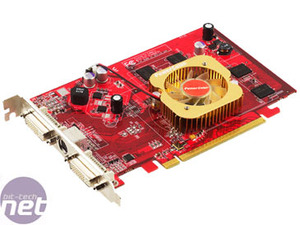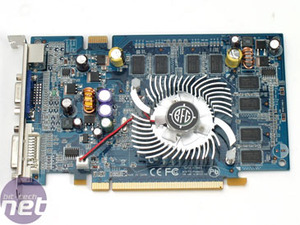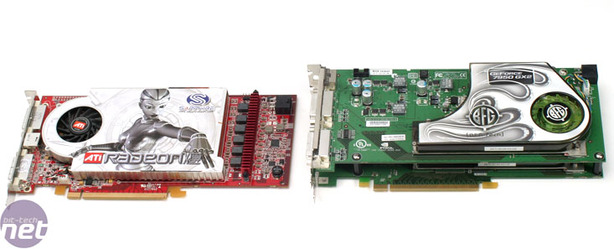We decided to examine multi-GPU performance across a number of different system price points.
Bjorn3D will go into more detail on the motherboards and CPUs we chose in our three price points. For the two low end systems we used a CrossFire Xpress 1600 motherboard from Abit for the ATI system and we are using a selection of nForce4 SLI motherboards for the NVIDIA $1000 US / £650 GBP machine - we were unable to source enough samples of the same motherboard for all publications to use exactly the same mobo. On top of this, we chose to use 1GB of PC3200 memory running at 2.5-3-3-7-1T and an AMD Athlon 64 X2 3800+.

 Based on our original price targets for the low-end multi-GPU system, we had around $230 US (£160) to spend on our graphics subsystem. This meant that our realistic multi-GPU purchasing options were a pair of Radeon X1600 Pro 256MB's for the ATI system and a pair of GeForce 7600 GS 256MB's for the NVIDIA system. Both can be purchased for around $95 US to $120 US, depending on the board partner and store. In the UK, we found the GeForce 7600 GS available for about £70, while the Radeon X1600 Pro 256MB was available for around the same price.
Based on our original price targets for the low-end multi-GPU system, we had around $230 US (£160) to spend on our graphics subsystem. This meant that our realistic multi-GPU purchasing options were a pair of Radeon X1600 Pro 256MB's for the ATI system and a pair of GeForce 7600 GS 256MB's for the NVIDIA system. Both can be purchased for around $95 US to $120 US, depending on the board partner and store. In the UK, we found the GeForce 7600 GS available for about £70, while the Radeon X1600 Pro 256MB was available for around the same price.
We increased the memory to 2GB, running at 400MHz (PC3200) with 2.0-3-2-7-1T timings and we also upgraded the CPU to an Athlon 64 X2 4400+. The overall cost of the hardware would not go above $2000 US / £1300 GBP. The CPU, motherboard and memory are not the only things that would be upgraded in this system - a larger power supply would also be required, and the end user may opt for a larger (or faster) hard drive. We worked out that the additional upgrades left us with around $600 US / £400 GBP to spend on a pair of video cards.
 We spent some time looking over the options, and had some trouble finding a widely-available mid-range solution from ATI. Since the Radeon X1800XT has been discontinued and is generally in short supply, it wasn't really a viable option for the purposes of this article. We spoke to ATI about the situation, and they told us that they were planning to enable 'masterless' CrossFire for the Radeon X1900GT in a couple of months time - it will probably make its way into Catalyst 6.8. ATI seeded us with a beta version of the driver for the purposes of this article series.
We spent some time looking over the options, and had some trouble finding a widely-available mid-range solution from ATI. Since the Radeon X1800XT has been discontinued and is generally in short supply, it wasn't really a viable option for the purposes of this article. We spoke to ATI about the situation, and they told us that they were planning to enable 'masterless' CrossFire for the Radeon X1900GT in a couple of months time - it will probably make its way into Catalyst 6.8. ATI seeded us with a beta version of the driver for the purposes of this article series.
Without this option, we would have had to over-spend because we would have had to change the second Radeon X1900GT for a Radeon X1900 CrossFire Edition card, which is around 50% more expensive than a Radeon X1900GT. In the UK, the Radeon X1900GT retails for around £200 including VAT, while the Radeon X1900 CrossFire Edition costs around £300 including VAT. In the US, the Radeon X1900GT retails for around $279 to $299, while the X1900 CrossFire Edition is going to cost over $460.
There were two choices for the NVIDIA video cards in the $600 / £400 price region - GeForce 7900 GT SLI or GeForce 7950 GX2. As Josh mentioned in his introduction, this could be a very controversial choice. However, we decided to go ahead with the choice because a single GeForce 7950 GX2 uses a pair of G71 GPUs on a single video card and delivers a better gaming experience than two pre-overclocked BFG Tech GeForce 7900 GTs in SLI for virtually the same price.
A pair of pre-overclocked GeForce 7900 GTs can be bought for around £180 each, while the GeForce 7950 GX2 ships for as little as £375. In the US, the GeForce 7950 GX2 sells for about $560 to $600, and a pair of GeForce 7900 GTs will cost you between $520 and $600, depending on clock speeds.
$1000 US / £650 GBP system:
At the bottom end of our scale, the group chose a $1000 US price point for the total cost of hardware. The cost of the system we're speccing doesn't include the cost of additional peripherals, a monitor and a copy of Windows XP - it just includes the cost of the basic hardware specification to get the PC to POST.Bjorn3D will go into more detail on the motherboards and CPUs we chose in our three price points. For the two low end systems we used a CrossFire Xpress 1600 motherboard from Abit for the ATI system and we are using a selection of nForce4 SLI motherboards for the NVIDIA $1000 US / £650 GBP machine - we were unable to source enough samples of the same motherboard for all publications to use exactly the same mobo. On top of this, we chose to use 1GB of PC3200 memory running at 2.5-3-3-7-1T and an AMD Athlon 64 X2 3800+.


$2000 US / £1300 GBP system:
For our mid-range systems, we stuck with AMD's trusty socket 939 - when this article series was originally planned to start, socket AM2 had only just been launched and there were limited options for mid-range socket AM2 motherboards. We used the CrossFire Xpress 3200-based Abit AT8 32X for the ATI CrossFire mid-range system, and the nForce4 SLI X16-based Abit AN8 32X for our NVIDIA SLI mid-range system.We increased the memory to 2GB, running at 400MHz (PC3200) with 2.0-3-2-7-1T timings and we also upgraded the CPU to an Athlon 64 X2 4400+. The overall cost of the hardware would not go above $2000 US / £1300 GBP. The CPU, motherboard and memory are not the only things that would be upgraded in this system - a larger power supply would also be required, and the end user may opt for a larger (or faster) hard drive. We worked out that the additional upgrades left us with around $600 US / £400 GBP to spend on a pair of video cards.

Without this option, we would have had to over-spend because we would have had to change the second Radeon X1900GT for a Radeon X1900 CrossFire Edition card, which is around 50% more expensive than a Radeon X1900GT. In the UK, the Radeon X1900GT retails for around £200 including VAT, while the Radeon X1900 CrossFire Edition costs around £300 including VAT. In the US, the Radeon X1900GT retails for around $279 to $299, while the X1900 CrossFire Edition is going to cost over $460.
There were two choices for the NVIDIA video cards in the $600 / £400 price region - GeForce 7900 GT SLI or GeForce 7950 GX2. As Josh mentioned in his introduction, this could be a very controversial choice. However, we decided to go ahead with the choice because a single GeForce 7950 GX2 uses a pair of G71 GPUs on a single video card and delivers a better gaming experience than two pre-overclocked BFG Tech GeForce 7900 GTs in SLI for virtually the same price.
A pair of pre-overclocked GeForce 7900 GTs can be bought for around £180 each, while the GeForce 7950 GX2 ships for as little as £375. In the US, the GeForce 7950 GX2 sells for about $560 to $600, and a pair of GeForce 7900 GTs will cost you between $520 and $600, depending on clock speeds.

MSI MPG Velox 100R Chassis Review
October 14 2021 | 15:04






Want to comment? Please log in.